Study Notes For Single-Phase Induction Motors | GATE Notes & Videos for Electrical Engineering - Electrical Engineering (EE) PDF Download
Principle of Operation of Single Phase Induction Motor
A single-phase induction motor is not self starting but requires some starting means.The single-phase stator winding produces a magnetic field that pulsates in strength in a sinusoidal manner. The field polarity reverses after each half cycle but the field does not rotate. Consequently, the alternating flux cannot produce rotation in a stationary squirrel-cage rotor. However, if the rotor of a single-phase motor is rotated in one direction by some mechanical means, it will continue to run in the direction of rotation. As a matter of fact, the rotor quickly accelerates until it reaches a speed slightly below the synchronous speed. Once the motor is running at this speed, it will continue to rotate even though single-phase current is flowing through the stator winding. This method of starting is generally not convenient for large motors.
The single-phase induction motor operation can be described by two methods
Cross-Field Theory
- The principle of operation of a single-phase induction motor can be explained from the cross-field theory. As soon as the rotor begins to turn, a speed emf E is induced in the rotor conductors, as they cut the stator flux FS.
- This voltage increases as the rotor speed increases. It causes current Ir to flow in the rotor bars facing the stator poles.
- These currents produce an ac flux FR which act at right angle to the stator flux Fs. Equally important is the fact that FR does not reach its maximum value at the same time as FS does, in effect, FR lags almost 90o behind FS, owing to the inductance of the rotor The combined action of FS and FR produces a revolving magnetic field, similar to that in a three-phase motor.
- The value of FR increases with increasing speed, becoming almost equal to FS at synchronous speed. The flux rotates counterclockwise in the same direction as the rotor and it rotates at synchronous speed irrespective of the actual speed of the rotor. As the motor approaches synchronous speed, FR becomes almost equal to FS and a nearly perfect revolving field is produces.
Double-Field Revolving Theory
- When the stator winding carries a sinusoidal current which is being fed from a single-phase supply, a sinusoidal space distributed mmf, whose peak or maximum value pulsates (alternates) with time, is produced in the air gap.
- The sinusoidal varying flux (φ) is the sum of two rotating fluxes or fields, the magnitude of which is equal to half the value of the alternating flux (φ/2), and both the fluxes rotating synchronously at the speed, in opposite directions.

- The above figure show the resultant sum of the two rotating fluxes or fields, as the time axis (angle) is changing from θ = (0°-180°).

The above figure shows the alternating or pulsating flux (resultant) varying with time or angle.
Types of Single-Phase Motors
Single-phase motors are generally built in the fractional-horsepower range and may be classified into the following four basic types:
- Single-phase induction motors
- (i) split-phase type (ii) capacitor start type (iii) capacitor start capacitor run type (iv) shaded-pole type
- A.C. series motor or universal motor
- Repulsion motors
(i) Repulsion-start induction-run motor (ii) Repulsion-induction motor - Single Phase Synchronous motors/Reluctance Motor
Single-Phase Induction Motors
These motors are most commonly used in domestic, commercial and industrial applications such as in fans, refrigerators, mixers, vacuum cleaners, washing machines etc. These are small size motors of fractional kilowatt ratings. These motors are simpler in construction as compared to 3-phase but their analysis is more complex.
Equivalent Circuit of a Single-Phase Induction Motor
Let Rl = Resistance of the main stator winding
Xl = Leakage reactance of the main stator winding
Xm = Magnetizing reactance
R2 = Standstill rotor resistance referred to the main stator winding
X2 = standstill rotor leakage reactance referred to the main stator winding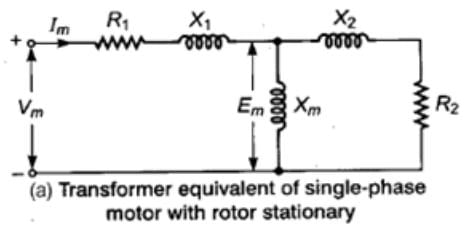
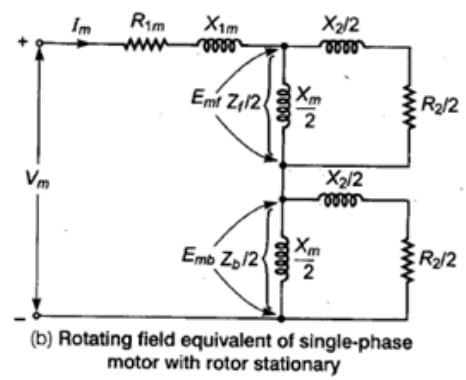
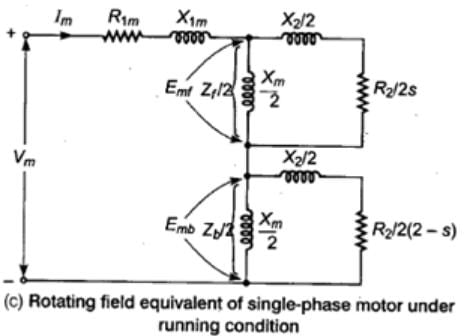
The simplified equivalent circuit of a single-phase induction motor with only its main winding energized is shown in figure.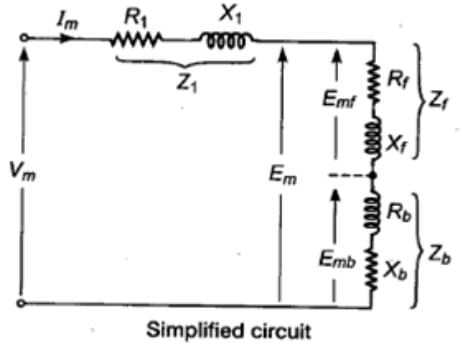
The current in the stator winding is 
Speed Torque Characteristic of Single Phase Induction Motor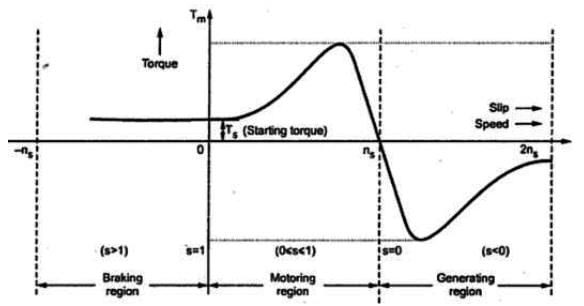
Here we can assume that the rotor is started by spinning the rotor or by using auxiliary circuit, in say clockwise direction. The flux rotating in the clockwise direction is the forward rotating flux (φf) and that in the other direction is the backward rotating flux (φb).
- The rotor rotates opposite to the rotation of the backward flux. If its slip with respect to forward field is s, what is the slip with respect to the backward field therefore, the slip w.r.t. the backward flux will be

Making Single-Phase Induction Motor Self-Starting
- Since we have already know that the single-phase induction motor is not self starting and it is undesirable to resort to mechanical spinning of the shaft or pulling a belt to start it.
- To make a single-phase induction motor self-starting, we should somehow produce a revolving stator magnetic field. This may be achieved by converting a single-phase supply into twophase supply through the use of an additional winding.
- When the motor attains sufficient speed, the starting means (i.e., additional winding) may be removed depending upon the type of the motor.
Making Single-Phase Induction Motor Self-Starting
- Since we have already know that the single-phase induction motor is not self-starting and it is undesirable to resort to the mechanical spinning of the shaft or pulling a belt to start it.
- To make a single-phase induction motor self-starting, we should somehow produce a revolving stator magnetic field. This may be achieved by converting a single-phase supply into two-phase supply through the use of an additional winding.
- When the motor attains sufficient speed, the starting means (i.e., additional winding) may be removed depending upon the type of the motor.
So as a matter of fact, single-phase induction motors are classified and named according to the method employed to make them self-starting.
- Split-phase type
- Capacitor start type
- Capacitor start capacitor run type
- Shaded-pole type
(i) Split-Phase Type
- The stator of a split-phase induction motor is provided with an auxiliary or starting winding S in addition to the main or running winding M.
- The starting winding is located 90° electrical from the main winding and operates only during the brief period when the motor starts up.
- The two windings are so resigned that the starting winding S has a high resistance and relatively small reactance while the main winding M has relatively low resistance and large reactance to be as inductance (the current delay with voltage) to make shifting current as shown in Figure.
- Consequently, the currents flowing in the two windings have a reasonable phase difference (25° to 30°) as shown in the pharos diagram this shifting in current its necessary for starting torque.
Operation
- When the two stator windings are energized from a single-phase supply, the main winding carries current Im while the starting winding carries current Is.
- Since main winding is made highly inductive while the starting winding highly resistive, the currents Im and Is have a reasonable phase angle a (25° to 30°) between them.
- Consequently, a weak revolving field approximating to that of a 2-phase machine is produced which starts the motor.
- When the motor reaches about 80% of synchronous speed, the centrifugal switch opens the circuit of the starting winding.
- The motor then operates as a single-phase induction motor and continues to accelerate till it reaches the normal speed. The normal speed of the motor is below the synchronous speed and depends upon the load on the motor.
The Capacitor Start Motor
The capacitor-start motor is identical to a split-phase motor except that the starting winding has as many turns as the main winding. The picture of capacitor start induction motor is shown in figure below,
Moreover, a capacitor C (3-20 µF) is connected in series with the starting winding as shown in Figure.The value of the capacitor is so chosen that IS leads Im by about 80° which is considerably greater than 25° found in the split-phase motor.
Operation
- When the two stator windings are energized from a single-phase supply, the main winding carries current Im while the starting winding carries current IS.
- Due to capacitance, the currents Im and Is have a reasonable phase angle an (80°) between them.
- When starting torque is much more than that of a split-phase motor Again, the starting winding is opened by the centrifugal switch when the motor attains about 80% of synchronous speed.
- The motor then operates as a single-phase induction motor and continues to accelerate till it reaches the normal speed.
- Capacitor-start motors are used where high starting torque is required and where the starting period may be long e.g., to drive:
(i) compressors (ii) large fans (iii) pumps (iv) high inertia loads The power rating of such motors lies between 120 W and 7-5 kW.
Capacitor Start-Capacitor Run Motor
- This motor is identical to a capacitor-start motor except that starting winding is not opened after starting so that both the windings remain connected to the supply when running as well as at starting.
- Two designs are generally used
(i) In first it shows a picture of capacitor start capacitor run induction motor. This design eliminates the need for a centrifugal switch and at the same time improves the power factor and efficiency of the motor.
(ii) In the other design, two capacitors C1 and C2 are used in the starting winding.The value of the capacitor is so chosen that Is leads Im by about 80°.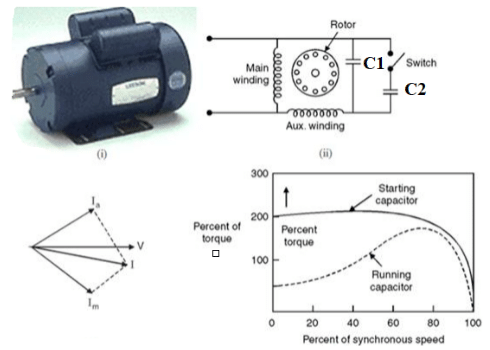
- The smaller capacitor C1 required for optimum running conditions is permanently connected in series with the starting winding. The much larger capacitor C2 is connected in parallel with C1 for optimum starting and remains in the circuit during starting.
- The starting capacitor C2 is disconnected when the motor approaches about 80% of synchronous speed. The motor then runs as a two-phase induction motor.
Operation
- When the two stator windings are energized from a single-phase supply, the main winding carries current Im while the starting winding carries current Is.
- Due to capacitance C1 the currents Im and Is have a reasonable phase angle an (80°) between them.
- When The starting capacitor C2 is disconnected when the motor approaches about 80% of synchronous speed. The motor then runs as a two-phase induction motor.
Characteristics
- The starting winding and the capacitor can be designed for perfect 2-phase operation at any load. The motor then produces a constant torque and not a pulsating torque as in other single-phase motors.
- Because of constant torque, the motor is vibration free and can be used in: (a) hospitals (b) studios and (c) other places where silence is important.
Shaded-Pole Motor
A typical shaded-pole motor with a cage rotor is a single-phase induction motor, with main winding in the stator. A small portion of each pole is covered with a short-circuited, single-turn copper coil called the shading coil. The sinusoidally varying flux created by ac (single-phase) excitation of the main winding induces emf in the shading coil. As a result, induced currents flow in the shading coil producing their own flux in the shaded portion of the pole.
main winding flux be φm = φmax sinωt (flux component linking shading coil)
(flux component linking shading coil)  (flux component passing down the air-gap of the rest of the pole)
(flux component passing down the air-gap of the rest of the pole)
The emf induced in the shading coil is given by (since single-turn coil)
(since single-turn coil) 
Let the impedance of the shading coil be 
The current in the shading coil can then be expressed as
The flux produced by isc is

where R is the reluctance of the path of φsc.
As per the above equations, the shading coil current (Isc) and flux (φsc) phasors lag behind the induced emf (Esc) by angle θsc; while the flux phasor leads the induced emf (Esc) by 90o.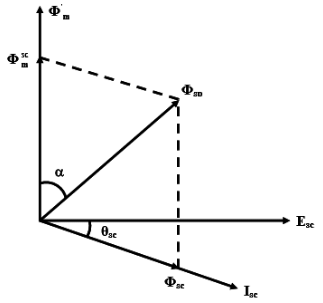
- The reversal of the direction of rotation, where desired, can be achieved by providing two shading coils, one on each end of every pole, and by open-circuiting one set of shading coils and by short-circuiting the other set.
- The above is true due to the fact that the shaded-pole motor is single-winding (no auxiliary winding) self-starting one, makes it less costly and results in rugged construction.
- The motor has low efficiency and is usually available in a range of 1/300 to 1/20 kW. It is used for domestic fans, record players and tape recorders, humidifiers, slide projectors, small business machines, etc.
- The shaded-pole principle is used in starting electric clocks and other single-phase synchronous timing motors.
|
27 videos|328 docs
|
FAQs on Study Notes For Single-Phase Induction Motors - GATE Notes & Videos for Electrical Engineering - Electrical Engineering (EE)
| 1. What is a single-phase induction motor? |  |
| 2. How does a single-phase induction motor work? |  |
| 3. What are the advantages of a single-phase induction motor? |  |
| 4. What are the limitations of a single-phase induction motor? |  |
| 5. How can the performance of a single-phase induction motor be improved? |  |
|
27 videos|328 docs
|

|
Explore Courses for Electrical Engineering (EE) exam
|

|



















